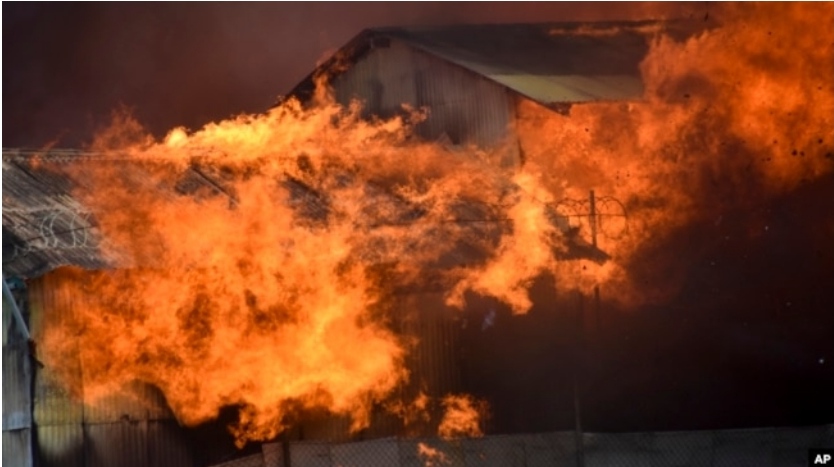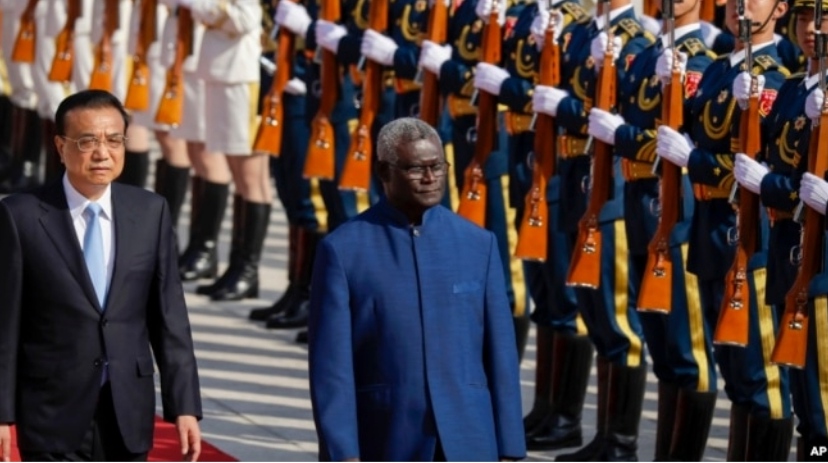An Unrest Eases in Solomon Islands after Australian Forces Arrive

A building burns in Chinatown, Honiara, Solomon Islands, Friday, Nov. 26, 2021.
Days of violent protests in the capital of the Solomon Islands eased Friday after Australian forces arrived to help re-establish order.
A demonstration that started peacefully in Honiara Wednesday turned into riots and looting that continued through early Friday. Police fired tear gas and rubber bullets at the protesters, who set fire to the National Parliament, a police station and many other buildings.
A small group of Australian police and military forces arrived in the capital in recent days to help local police gain control of the situation. A curfew was set to go into effect at 7 p.m. local time.
The forces were requested by Prime Minister Manasseh Sogavare under a security agreement his government has with Australia. Australian Foreign Minister Marise Payne said the forces were expected to stay in the Solomon Islands “for a matter of weeks.”
The protesters were demanding the resignation of Sogavare. He has been widely criticized by leaders of the South Pacific nation’s most populous island, Malaita, for his 2019 decision to drop diplomatic ties with Taiwan in favor of mainland China.
Sogavare blamed the protests on interference from foreign governments. While he did not name specific nations, he said the interference had helped fuel the violence.
Pressures from outside the country were a “very big…influence,” The Associated Press reported Sogavare as saying. “I don’t want to name names. We’ll leave it there,” he added.
Sogavare’s government has been upset over millions of dollars in U.S. aid that has been promised directly to Malaita, rather than through the central government. That issue is the latest in a series that have caused tense relations between Malaita and the main island of Guadalcanal, where the capital Honiara is.
“Most of the drivers of the tension have been in the country for many decades and generations,” said Jonathan Pryke, who spoke to the AP. He is an expert on the South Pacific and the director of the Sydney-based Lowy Institute.
Pryke said the tensions are linked to the country’s longstanding problems with poverty, limited economic development and inter-ethnic rivalries. “So everyone’s pointing fingers, but some fingers also need to be pointed at the political leaders of the Solomon Islands,” he added.

In this file photo, Chinese Premier Li Keqiang, left, and Solomon Islands Prime Minister Manasseh
Sogavare review an honor guard during a welcome ceremony at the Great Hall of the People in Beijing, Wednesday, Oct. 9, 2019.
Critics also blamed the unrest on poor government services, corruption and Chinese businesses giving jobs to foreigners instead of locals.
Since the government ended its ties with Taiwan and established them with China in 2019, there has been an expectation of massive infrastructure investment from Beijing. But with the COVID-19 pandemic beginning shortly after the change, the Chinese investment has been delayed.
Malaita had threatened to hold a referendum on independence over the issue, but the move was blocked by Sogavare’s government.
The prime minister said Friday he stood by his government’s decision to establish ties with China. He said he believes that government position was the “only issue” linked to the violence.
By Bryan Lynn for VOA



